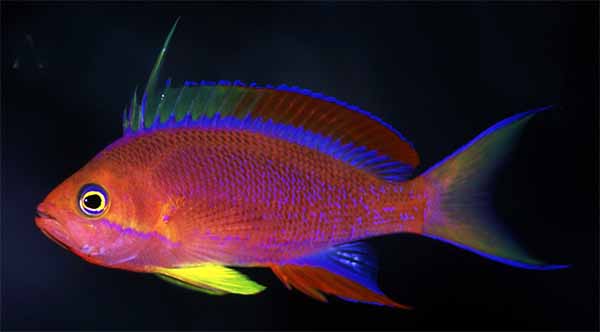Pseudanthias tequila
Gill et al., 2017
|
Familie: Serranidae Lokale Bezeichnung |
Typen
Holotypus: KPM-NI 3759.
Paratypen: KPM-NI 3758.
Typusfundort: Japan, Ogasawara Islands, Chichi-jima Islands, Ototo-jima Island, 40 m Tiefe.
Etymologie
Das Art-Epitheton bezieht sich auf das alkoholische Getränk Tequila Sunrise, das auf die lebhaften Farben der Männchen der Art anspielt.
Verbreitung
Pseudanthias tequila wurde beschrieben anhand von zwei Exemplaren von Ototo-jima, Chichi-jima Inseln, Ogasawara Inseln, Japan. Die Autoren erfassen die Art auch auf der Grundlage von Fotos, die sie von Guam, Saipan und Tinian auf den Marianen zeigen. Kuiters (2004) Fotografie eines Individuums von Pseudanthias cf. randalli, das angeblich aus Palau stammt, bezieht sich auf P. tequila. Jedoch hat R. F. Myers den Autoren mitgeteilt, dass das Foto von Hiroyuki Kimura tatsächlich aus Saipan stammt. Andere Photographien aus Palau sind auf die nahe verwandte Art Pseudanthias randalli (Lubbock & Allen, 1978) zurückführbar. Die ursprüngliche Beschreibung von P. randalli enthielt auch Paratypen aus Palau. Pseudanthias tequila scheint vor allem in Höhlen an Riffhängen in 40-60 m Tiefe zu finden sein. In Saipan und Tinian hingegen kommt sie im Freien an Riffhängen vor, die von Halimeda- und Caulerpa-Algen dominiert werden.
IUCN Status

CR Critically Endangered (vom Aussterben bedroht)
EN Endangered (stark gefährdet)
VU Vulnerable (gefährdet)
NT Near Threatened (potenziell gefährdet)
LC Least Concern (nicht gefährdet)
RE Regionally Extinct (regional oder national ausgestorben)
DD Data Deficient (ungenügende Datengrundlage)
NE Not Evaluated (nicht beurteilt)
Status: Stand 10.11.2017: NE Not Evaluated (nicht beurteilt)
Literatur
- Myers, R.F. & Shepard, J.W. 1980. New records of fishes from Guam, with notes on the ichthyofauna of the southern Marianas. Micronesica, 16: 304–347. Zitatseite [: 316 (Blue Hole, Orote Peninsula, Guam) als Pseudanthias randalli]
- Myers, R.F. 1988. An annotated checklist of the fishes of the Mariana Islands. Micronesica, 21: 115–180. Zitatseite [: 140 (Guam) als Pseudanthias sp.]
- Michael, S.W. 1998. Reef Fishes: A Guide to Their Identification, Behaviour, and Captive Care. Vol. 1. Microcosm Ltd, Shelburne, 624 pp. Zitatseite [: 576 (Farbfoto; Guam) als Pseudanthias sp. 3]
- Myers, R.F. 1999. Micronesian Reef Fishes. 3rd ed. Coral Graphics, Guam, USA, 330 pp. Zitatseite [: 109, pl. 35 G (Farbfoto; Guam) als Pseudanthias sp. B]
- Myers, R.F. & Donaldson, T.J. 2003. Fishes of the Mariana Islands. Micronesia, 35‒36: 598‒652. Zitatseite [: 616 (gelistet, Marianas Islands) als Pseudanthias flavicauda]
- Kuiter, R.H. 2004. Basslets, Hamlets and Their Relatives. A Comprehensive Guide to Selected Serranidae and Plesiopidae. TMC Publishing, Chorleywood, 216 pp. Zitatseite [: 61, unnummeriertes Farbfoto, figs A and B (Farbfotos; Palau, Saipan und Guam), als Pseudanthias cf. randalli]
- Kuiter, R.H. & Debelius, H. 2006. World Atlas of Marine Fishes. IKAN-Unterwasserarchiv, Frankfurt, 720 pp. Zitatseite [: 298 (Farbfoto; Micronesia) als Pseudanthias cf flavicauda]
- Gill, A.C., Tea, Y.-K. & Senou, H. 2017. Pseudanthias tequila, a new species of anthiadine serranid from the Ogasawara and Mariana Islands. Zootaxa, 4341 (1): 67-76. (doi) Zitatseite [: 68, Figs. 1-3, 4A-B, 5-6, !!]
